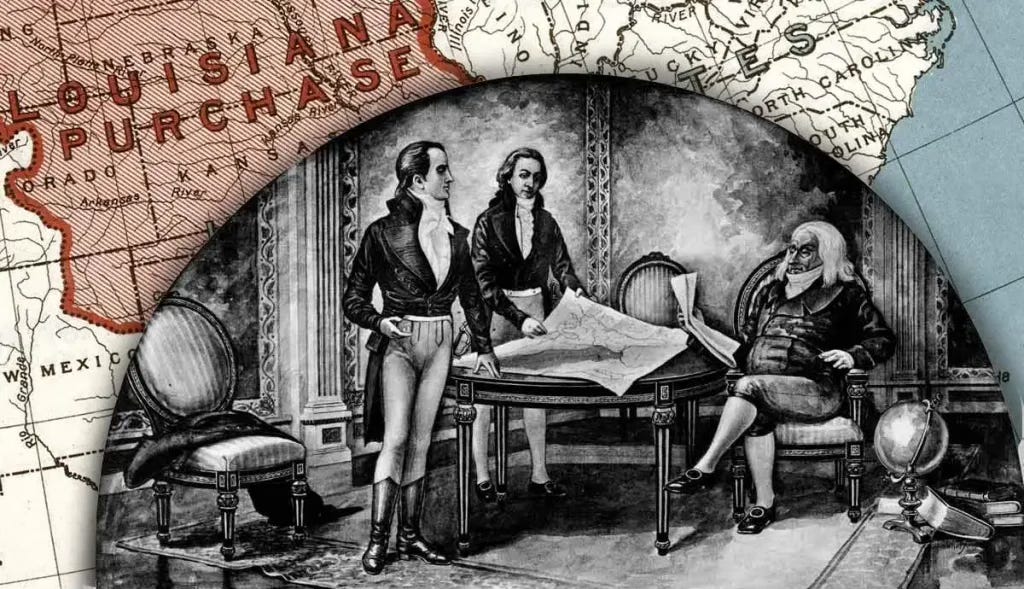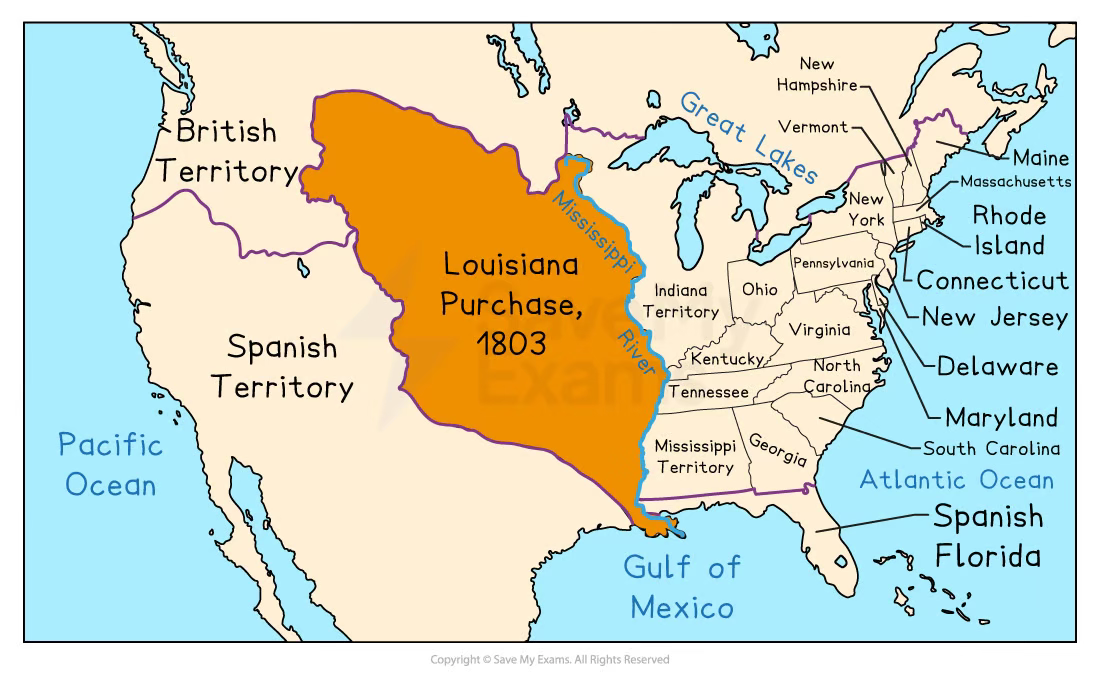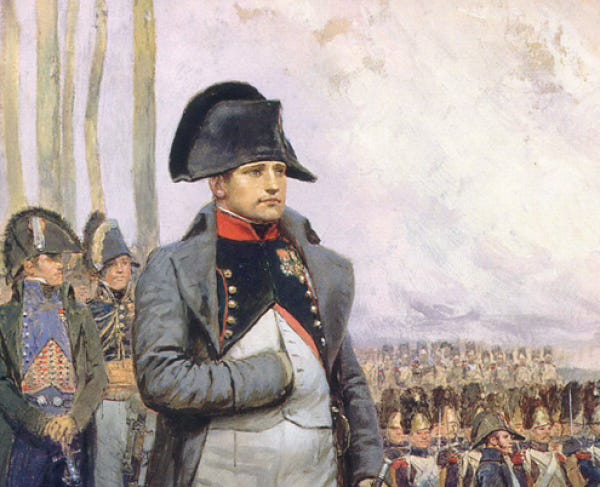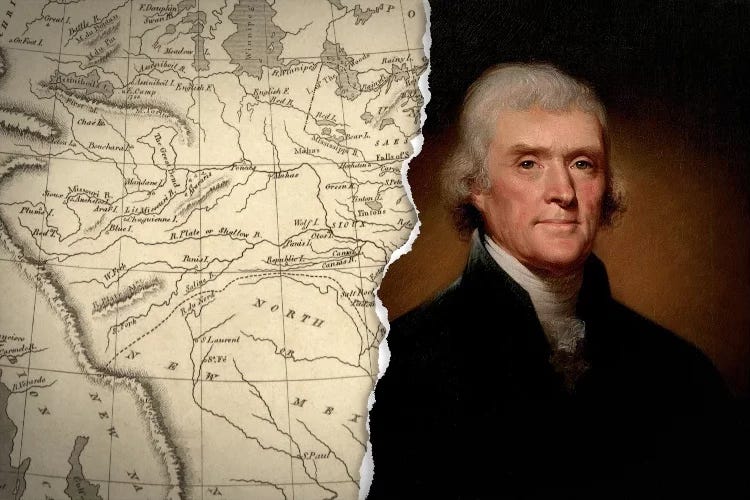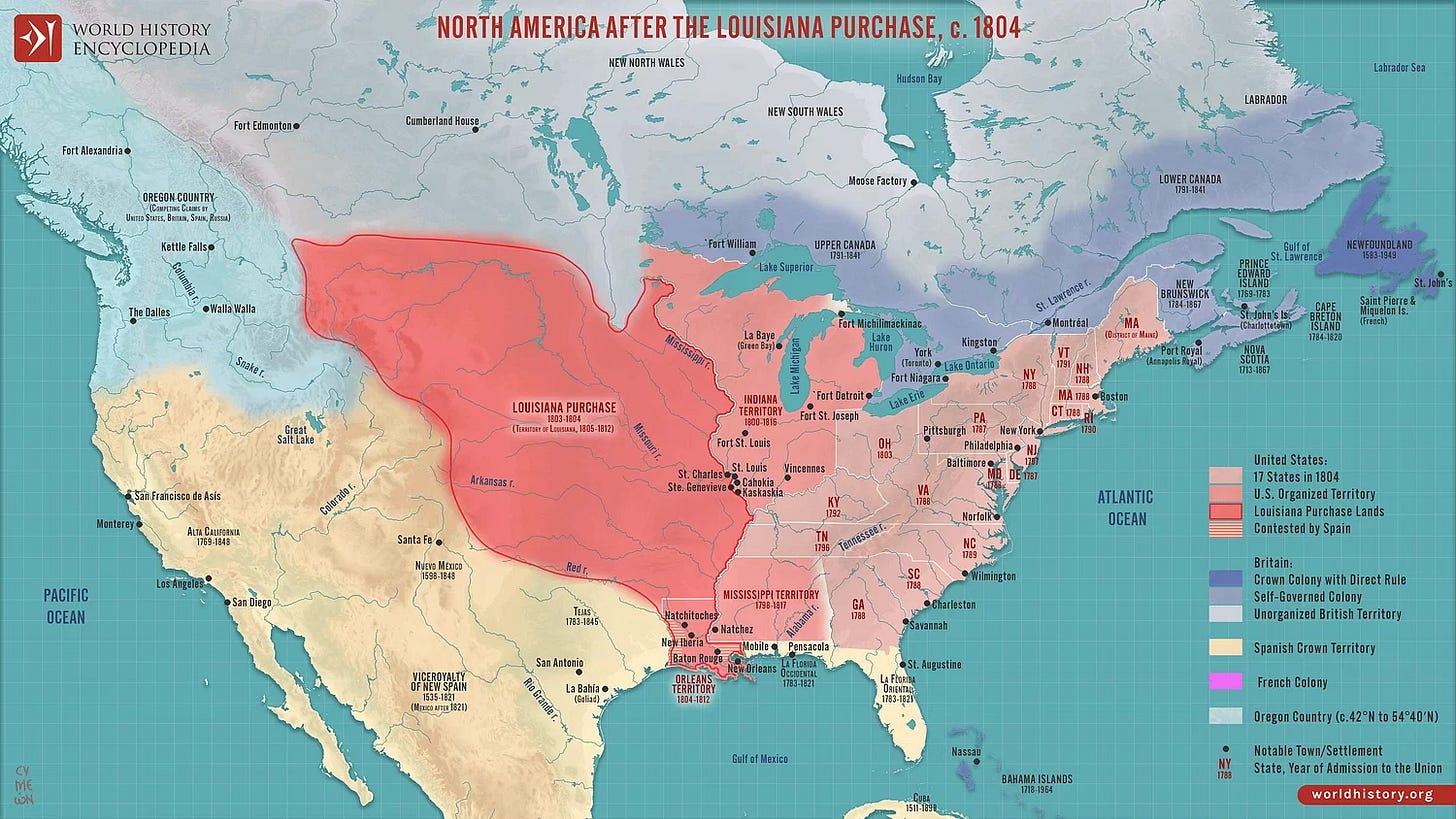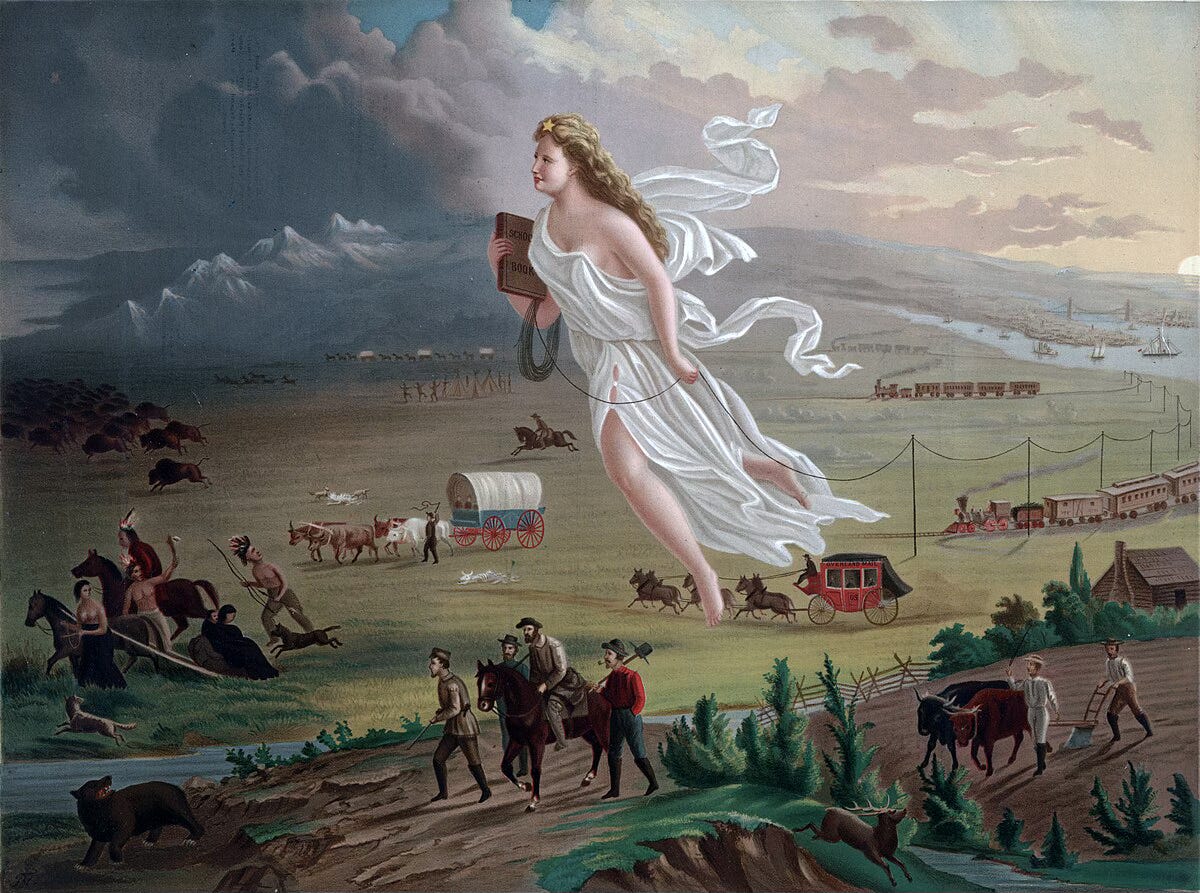The Louisiana Purchase Part 3 - Diplomatic Ripples: How the Louisiana Purchase Shook Europe and Spain
This is the third installment of a 7-Part Weekly Series on The Louisiana Purchase
In 1803, a single land deal between the United States and France forever changed the trajectory of American history. The Louisiana Purchase didn’t just redraw the map of North America—it redefined the scope of American ambition and sent diplomatic shockwaves across the Atlantic. With one stroke of the pen, the United States doubled in size, securing control of critical rivers, trade routes, and vast, untamed wilderness. But the true magnitude of the deal extended far beyond American borders.
To the great powers of Europe, this was more than a routine real estate transaction. It was a geopolitical thunderclap. France had sold; America had bought—but Spain felt betrayed, Britain grew uneasy, and rival empires began recalibrating their strategies. In a world still dominated by colonialism and imperial rivalries, the boldness of this young republic signaled something new. The United States was no longer a fragile experiment on the edge of civilization—it was a rising force capable of reshaping continents and altering the balance of global power.
What appeared on the surface as a straightforward land transfer was, in truth, a diplomatic bombshell—one whose aftershocks would reverberate for decades across the Western world.
Spain’s Shock and Anger: A Strategic Betrayal
Spain’s reaction to the Louisiana Purchase was one of stunned outrage. Just three years earlier, in 1800, Spain had signed the secret Treaty of San Ildefonso, transferring control of the Louisiana Territory back to France after decades of Spanish rule. The agreement was meant to be a quiet, calculated move—Spain believed that Napoleon’s France, with its strong military and global reach, would act as a buffer between Spanish colonies and the increasingly assertive United States.
Instead, France turned around and sold the territory to the very power Spain feared most. To Spanish officials, it felt like a diplomatic betrayal—Napoleon had promised not to sell Louisiana to a third party without Spain’s consent, a promise he clearly broke. The deal blindsided the Spanish crown, which had hoped to maintain a protective barrier between U.S. settlers and its remaining colonies in North America, particularly Mexico, Florida, and the remote province of Texas.
Spanish leaders were especially concerned about the vague and shifting boundaries of the territory in question. With no clear demarcations, American officials could—and soon would—lay claim to lands Spain still considered its own. Diplomats and military commanders in Spanish America braced for increased tensions and possible territorial disputes.
The betrayal wasn't just political—it was strategic. Spain had long struggled to defend its vast, loosely held territories in the Americas. With France abandoning the region and the United States stepping in with newfound momentum, Spain suddenly found itself alone and exposed. The Louisiana Purchase marked the beginning of the end for Spain’s dominance in the New World, triggering a sense of urgency and paranoia that would shape its foreign policy for years to come.
Britain Watches Warily
Across the Atlantic, King George III and Great Britain observed the Louisiana Purchase with cautious concern. At first glance, the transaction may not have seemed like an immediate threat—after all, Britain and the United States were not yet at war, and France’s retreat from North America arguably reduced French influence in the Western Hemisphere. But beneath the surface, British officials understood the deeper implications: the United States had just taken a massive step toward becoming a continental power.
The timing of the deal was particularly unsettling. Britain was already locked in a prolonged and costly struggle with Napoleonic France. The last thing London wanted was for France to generate revenue—or worse, strengthen a potential ally—by transferring a vast territory to the Americans. Though Britain did not formally oppose the sale, political leaders feared that the United States might one day challenge British control in Canada or disrupt maritime trade routes in the Atlantic and Caribbean.
Adding to the tension was the question of alliances. Britain worried that the United States, still a relatively young republic with unresolved grievances from the Revolutionary War, might tilt toward France in the broader geopolitical contest. The Louisiana Purchase heightened those fears. British diplomats began monitoring U.S. actions more closely, wary of any American moves that could undermine British interests in the Americas.
The acquisition also shifted Britain’s long-term strategic calculus. No longer could the U.S. be dismissed as a minor coastal power. With access to the Mississippi River and beyond, the U.S. now had the geographical reach and resources to project influence deep into the continent—perhaps even into British-held territories. For Britain, the Louisiana Purchase didn’t just change the map; it altered the strategic balance of the New World and introduced a new, unpredictable player into the great game of empire.
Napoleon’s Calculated Move
For Napoleon Bonaparte, the Louisiana Territory was less of a prized colonial asset and more of a burdensome gamble that no longer fit his imperial priorities. When he reacquired the territory from Spain in 1800 through the secret Treaty of San Ildefonso, his original plan was to rebuild a French empire in the Americas. The strategy hinged on using the fertile lands of Louisiana to support France’s lucrative Caribbean colonies, particularly Saint-Domingue (modern-day Haiti), the crown jewel of French colonial wealth due to its sugar production.
But those ambitions unraveled quickly. A massive slave revolt led by Toussaint Louverture in Saint-Domingue had turned into a full-scale revolution. Despite sending thousands of troops to restore order, Napoleon’s forces were decimated by a combination of guerrilla warfare and yellow fever. By 1803, he had lost control of the colony—and with it, the centerpiece of his western empire. Without Saint-Domingue, Louisiana became far less valuable, and maintaining such a vast and distant territory became more of a liability than an asset.
Meanwhile, in Europe, Napoleon was preparing for renewed war with Britain and needed money to fund his military campaigns. Selling Louisiana offered a solution to both problems: it provided a quick infusion of cash—$15 million, a staggering sum at the time—and eliminated the need to defend or govern a sprawling North American territory.
Strategically, the sale also had a spiteful edge. By strengthening the United States, Napoleon hoped to frustrate British interests in the Western Hemisphere. An empowered America could serve as a counterweight to British colonial dominance and maritime power. Though the move was born of necessity, it was not without foresight—Napoleon saw in the United States a tool that could, over time, complicate Britain’s imperial ambitions.
In the end, Napoleon’s decision to sell Louisiana was pragmatic, calculated, and rooted in a distinctly European focus. He traded a theoretical empire in the Americas for real gains in Europe, never fully realizing that he had just enabled the rise of a rival power that would one day surpass them all.
A New Player on the Global Stage
The Louisiana Purchase marked a turning point in the way the world viewed the United States. Just three decades removed from the Declaration of Independence, the young republic had already proven its resilience on the battlefield and in the political arena—but now, it had done something equally powerful through diplomacy. By negotiating the largest peaceful land acquisition in history, the United States sent a clear message: it was no longer a scrappy collection of former colonies clinging to the Eastern Seaboard. It was a nation with vision, leverage, and global ambition.
The deal instantly elevated America’s status in the eyes of European powers. The fact that the U.S. had not only negotiated directly with one of the world’s most formidable rulers—Napoleon Bonaparte—but had done so on favorable terms, shocked many in the old world. Foreign diplomats began treating American envoys with more caution and respect, recognizing that the U.S. had both the political will and the resources to play on the world stage.
Domestically, the purchase also stirred a new sense of national identity and purpose. Americans began to view their country as destined for greatness—not confined to the coast, but stretching westward into the vast, uncharted interior. The acquisition fueled dreams of exploration, commerce, settlement, and ultimately, continental dominance. It wasn’t just about land; it was about legitimacy. The United States had taken a seat at the table of empires, and the world took note.
Moreover, the success of the Louisiana Purchase helped establish a precedent for future U.S. foreign policy—one that favored expansion through negotiation, economic leverage, and strategic timing. It signaled that America could be both principled and pragmatic in its dealings, and that it would not shy away from reshaping borders when opportunity struck.
In the eyes of many global observers, the Louisiana Purchase transformed the United States from a regional curiosity into an emerging power—a nation willing to assert itself and redefine the balance of influence in the Western Hemisphere.
Border Disputes: Texas and Florida in the Crosshairs
(Zoom in on picture to see the borders and where modern day Louisiana, Texas, and the Florida Paraishes were located)
While the Louisiana Purchase was celebrated in the United States as a triumph of diplomacy and national growth, it immediately raised a thorny question: where, exactly, did this new territory begin and end?
The purchase agreement with France was vague on boundaries. At the time, no one—neither American negotiators nor Napoleon himself—could clearly define the western and southern edges of the Louisiana Territory. This ambiguity set the stage for years of friction between the United States and Spain, which still held vast stretches of North America to the south and west, including Florida, Texas, and Mexico.
The biggest flashpoints became the provinces of West Florida and Texas. U.S. officials claimed that the Louisiana Territory extended all the way to the Rio Grande, which would have included large parts of Spanish Texas. Spain, of course, fiercely rejected that claim. Similarly, the U.S. asserted that parts of West Florida—an area including present-day southern Alabama, Mississippi, and the Florida panhandle—were also included in the purchase, though they had been under Spanish control for decades.
The confusion wasn’t just cartographic—it was geopolitical. Settlers, traders, and military units from both sides pushed into disputed areas, creating tension and sometimes direct confrontation. Spain fortified its border defenses, and American expansionists began agitating for greater control over the Gulf Coast and the Southwest.
Diplomats tried to manage the conflict through negotiation, but neither side was willing to concede ground easily. Tensions simmered throughout the early 1800s and intensified as American settlers poured into disputed regions, ignoring Spanish authority and fueling calls for annexation.
Ultimately, these unresolved disputes led to the Adams-Onís Treaty of 1819, also known as the Transcontinental Treaty. Under this agreement, Spain ceded Florida to the United States and agreed to a definitive western boundary for Louisiana—drawing a line that stretched from the Gulf of Mexico up the Sabine River, across the Red and Arkansas Rivers, and along the Rocky Mountains.
But the border issues surrounding the Louisiana Purchase did more than clarify lines on a map—they laid the groundwork for America’s growing appetite for territory. The aggressive U.S. stance during these disputes foreshadowed future conflicts, including the annexation of Texas, the Mexican-American War, and the continued push for continental expansion under the banner of Manifest Destiny.
In hindsight, the Louisiana Purchase didn’t just create new borders—it also ignited a new kind of conflict: one where maps were redrawn not by empires, but by ambition.
A Legacy of Expansion
The Louisiana Purchase didn’t just change the physical landscape of the United States—it transformed its national identity. The acquisition established a precedent that would shape American policy, ideology, and ambition for generations to come. It was, in every sense, the beginning of the American empire.
By securing over 828,000 square miles of territory, the United States signaled to the world—and to itself—that it intended to grow. What had begun as a small republic hugging the Atlantic coast was now a continental force with eyes on the horizon. The sheer scale of the land acquired invited exploration, migration, and economic opportunity. It also raised deeper philosophical questions: Was this expansion divinely ordained? Was it inevitable?
These ideas would coalesce in the decades that followed into the powerful ideology of Manifest Destiny—the belief that the United States was destined to stretch from the Atlantic to the Pacific, spreading democracy, commerce, and civilization. The Louisiana Purchase planted the seeds of that vision. It normalized territorial acquisition as a legitimate—and even noble—pursuit.
At the same time, the purchase exposed the United States to complex challenges: how to govern vast, diverse, and largely unknown lands; how to manage relations with Indigenous nations who already lived there; and how to handle diplomatic friction with neighboring empires like Spain and, later, Mexico. Many of these tensions would erupt into future conflicts—but the course had already been set.
For Spain, the Louisiana Purchase accelerated its decline in the Americas. Isolated and diplomatically outmaneuvered, Spain would gradually lose control of Florida and, eventually, much of its colonial grip in the Western Hemisphere. For France, it marked the end of its imperial dreams in North America. And for Britain, it introduced a fast-growing neighbor whose influence would eventually stretch across the continent—and beyond.
The legacy of the Louisiana Purchase is not merely one of land—it’s one of mindset. It expanded the boundaries of what Americans believed their nation could be. It taught the U.S. government how to negotiate big, bold deals. And it introduced the idea that America’s future wasn’t limited by the edge of the map, but only by the scope of its ambition.
In that sense, the Louisiana Purchase didn’t just double the size of the country—it redefined its destiny.
Sources & Further Reading
U.S. National Archives – Louisiana Purchase Exhibit
Library of Congress – Louisiana Purchase Primary Docs
Britannica – Louisiana Purchase Overview
Gauthier, David P. The Louisiana Purchase as a Diplomatic Crisis
Fowler Jr., William M. Empires at War: The French and Indian War and the Struggle for North America
Coming Next in This Series from The Bayou Insider:
An Empire of Liberty: Jefferson’s Vision for America
The Price of Expansion: Financing the Louisiana Purchase
America’s Inheritance: The Natural Wealth of the Territory
Controversy and Consensus: How the Nation Reacted
Subscribe now to follow the full series as we explore the far-reaching impact of one of America’s most important land deals.
💬 Enjoyed This Story? Stay Connected.
If you enjoyed this deep dive into the Louisiana Purchase, we invite you to subscribe to The Bayou Insider for more stories that explore Louisiana’s rich history, culture, politics, and people. This article is the first in a special series on the lasting impact of the Louisiana Purchase—so don’t miss what’s coming next.
🔔 Subscribe now to get future installments delivered straight to your inbox.
🔁 Share this post with friends, students, history lovers, or anyone who enjoys learning about the bold decisions that shaped our nation.
💬 Join the conversation in the comments—we’d love to hear your thoughts, questions, or reflections.
At The Bayou Insider, we believe Louisiana’s story is America’s story. Let’s explore it together.
The Louisiana Purchase Part 2 - Mapping a Nation: Surveying the New American Frontier
By The Bayou Insider Staff




